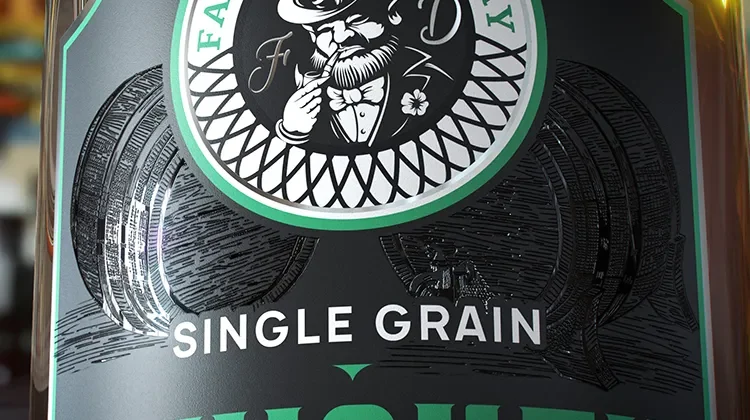
By Liz Stevens, writer, PostPress
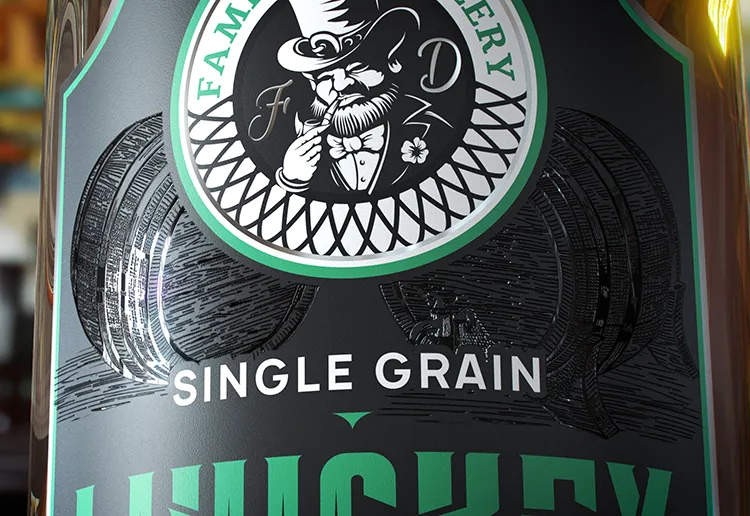
The design and production of roll-to-roll embellished product labels evolve as the buying public becomes more discerning and as pressure increases for greater sustainability in the production process. To keep up with demand, label producers must explore and embrace new technologies for creating stand-out labels while simultaneously adopting new production methods that cut costs and tread more lightly on the planet. PostPress took a look at forecasts for the label market and drew insight from players in the sector about the current state of affairs.
Market Stats and Forecast for the Near-Term
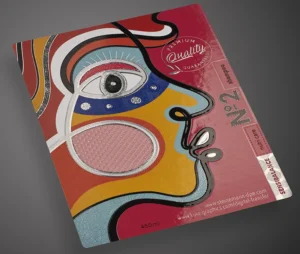
According to Labels and Labeling’s “Sustainability and digital innovation to power label market’s growth,” 1 which cites information from Smithers’ “The Future of Printed Labels to 2029 Report,” the total global market value will reach USD 44.8 billion in 2024. A stable market should lead to 3.8% CARG through 2029, which will increase total global market value to USD 54.1 billion. Growth in sales of packaging labels will be prompted by sustainability issues and innovations in digital printing.
The Smithers report predicts that new graphic and embellishment techniques, along with connected label technology and security markings, also will drive growth. The adoption of artificial intelligence for label design and layout, and the use of advanced QC and visual inspection technologies, will continue to be time-saving positives for label production. In the largest end-use segments for printed labels – beverages and food products – healthy market growth will stem from new labeling requirements for ingredient, allergen and nutrition data, as well as the continued push for label recyclability.
Per the recent Alexander Watson Associates (AWA) evaluation of the label and package printing market, as cited in Label and Narrow Web’s “Mid-Year Economic Report,” 2 significant challenges as well as plentiful opportunities will affect the industry. Emerging advanced technologies will be welcomed to mitigate continuing economic and workforce challenges.
Digital Embellishments and Labels
As digital printing technologies continue to grow for roll-to-roll label applications, embellishing labels through digital inkjet and digital toner technologies continues to grow as well. Specialty markets with smaller label runs have helped spark this growth.
Kurz has introduced roll-to-roll digital embellishment technology with its patented process where the inkjet image is printed on the back of the transfer foil, opening up applications for metallic finishes that have never been done before. The process can be used on a wide range of substrates beyond just coated label stock, including uncoated stocks and thin film materials. “This technology allows for automatic job recognition and instant order change,” commented Michael Aumann, global director – Digital Embellishment Solutions at KURZ. “This results in continuous operation with no stops for job changeover, set-up or makeready.”
Kurz also offers the versatility to apply metallic decoration to printed materials from a toner-based printing platform. The technology is based on its combination of Xeikon’s durable TITON toner and KURZ DIGITAL METAL© transfer foil applied inline on the Xeikon TX500 press and KURZ R520 embellishment unit. KURZ also has 3D inkjet technology for roll-to-roll applications, combining the spot-coating process with the application of a raised or flat metallic decoration, which can be completed in one pass.
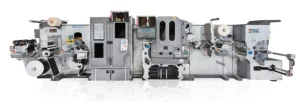
CARTES offers many digital embellishment and finishing solutions for label applications. These include incorporating laser diecutting with digital foil embellishments all inline, providing a complete digital finishing solution. “Our Jet D-Screen for digital foil embellishments is a state-of-the-art technology designed to create outstanding labels garnished by multi-layered effects,” explained Michael Debard, president of Diversified Graphic Machinery, representing CARTES. “This includes spot coating, complex tactile raised volumes and braille printing, as well as detailed foiling of metallic-doming transferring.”
A B Graphic International’s digital embellishment module, DigiJet, is a fully digital system for roll-to-roll label decorating either inline or offline. “The DigiJet allows for multiple processes in one pass, including spot varnishing, digital cold foiling and tactile screen effects on any size print runs with no tooling,” stated Floriana Montella, product manager. “Our technology allows users to maximize their productivity with zero tooling, zero waste and market-leading levels of efficiency. The Digijet is a module of the Digicon Series 3 and is the perfect match with Digilase, ABG’s laser diecutting machine.”
Another option for roll-to-roll label embellishments is Konica Minolta’s new JETvarnish 3D Web 400, a 100% web-fed digital embellishment solution that integrates spot UV varnish, hot foil stamping and variable data printing in a single pass. “Tailored for the evolving needs of the self-adhesive label and flexible packaging sectors, the JETvarnish 3D Web 400 enables converters and printers to reduce customers’ time-to-market, while transforming the impact of their labels and packaging on the shelf,” commented Frank Mallozzi, president, Industrial & Production Print, Konica Minolta. “It meets the requirements for short, medium and long runs by enhancing basic four-color production with digital spot UV varnish and hot foil stamping in fixed or variable data, flat or embossed, facilitating multi-runs and versioning.”
Cold Foil Transfer on Labels
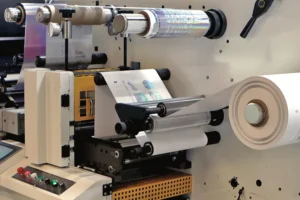
The use of cold foil transfer inline with roll-to-roll label printing has been popular for many years. However, in the past, there was a question on overall brilliance of a cold foil transfer compared to hot stamping the foil inline on a roll-to-roll flexo press. The quality of cold foil has improved tremendously and has its place with label embellishments.
“Brands often use foil because of its glossy, high-visibility effects. Research has shown that packaging decorated with foil rates more effective than non-foil packaging,” remarked Gary Bibler, director of new creative business for K Laser Technology (USA) Co. “The use of cold foil on roll-to-roll can be less expensive for production than other applications. Roll-to-roll also can be beneficial for certain jobs, reducing waste as opposed to sheet-run projects.”
Bibler added that cosmetics packaging is a highly competitive market, and the luxury component is key. The cold foil – even in a minimal application – adds distinct value. Cannabis and the CBD market have become increasingly powerful as well. The use of foil embellishment, combined with creative artwork for packaging, has allowed for higher consumer awareness.
Another advantage of a cold foil transfer unit is the ability to use it to apply Cast and Cure. The Cast and Cure process provides a clear holographic pattern over the label and can be applied in a similar manner as cold foil, using a clear adhesive that then is UV-cured inline. The main difference is that nothing from the film carrier is applied to the label stock and the Cast and Cure film can be used several times.
Hot Foil Stamping for Roll-to-Roll
Although there has been tremendous growth in both cold foil transfer and digital foil technologies in the decoration of labels, more traditional hot stamping still is popular for many roll-to-roll label applications. Hot stamping is being performed both inline on a flexographic press using an engraved brass rotary die or offline on a dedicated roll-to-roll hot stamping press utilizing flat engravings.
The advantage of the inline process certainly is the ability to add the foil and embossing in one pass. The advantage of the offline process, where flat dies can be used, is that the overall tooling costs are much lower. The size of the label job usually will determine the best approach.
Telstar’s Interprint Die Station is an inline option for most flexo printing machines and bridge-mounts above any two flexo print units. Die frames match the dimensions of the parent machine so that all press tooling is interchangeable. The servo drive features auto and re-register capabilities. The hot stamp system features a digital touchscreen control unit with recipes for steel, brass and magnetic dies. There also are various anvil coverings available for improved performance on hot stamping, heat sealing and embossing.
“[With] many applications for high-end labels, including wine and cosmetic labels, the brand owner still wants the crisp hot foil stamping look,” stated Tom Kirtz, president at TelStar Engineering, Inc. “In addition, many wine labels are produced on an uncoated, textured stock. Hot stamping is the best choice when adding a metallic finish.”
Future Trends with Label Embellishments
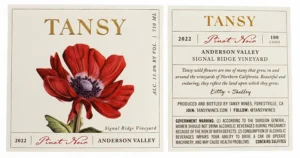
Paragon Label, Petaluma, California, offers high-quality labels for the wine, beauty and food brand markets. The company offers a variety of printing and embellishment options for its clients. Jeremy Jolly, general manager for Paragon, has seen embellishments and other specialty techniques continue to grow for label applications.
“At Paragon, we offer rotary screen, flatbed foil stamping and embossing, as well as decorative laser cutting, with decorative laser cutting being our newest addition,” stated Jolly. “The spirits market is doing the most interesting things with embellishments currently. We are seeing a wider range of stocks and methods being used there vs. other markets.”
“More and more, manufacturers are beginning to realize the opportunities that digital embellishment technology allows – such as instant order change,” remarked Aumann. “The ability to combine multiple label jobs on one roll and instantly change from job to job based on automated job recognition can result in higher levels of production efficiency and time savings in the digital embellishment process.”
Aumann also explained that combining digital embellishments with conventional embellishments can produce stunning effects mixed with variable imaging and versioning.
Woodcock has seen a rise in the need for embellishments on fast-moving consumer good labels. “The rise in popularity of fitness supplements and protein powders has required more premium labels to rise above competition and look more appealing on supermarket shelves,” he said.
“Every day, it becomes more important to preserve the image of products and guarantee that their quality is consistent with market requirements,” added DeBard. “To this end, companies in constant competition always seek to differentiate their products with special features like foil embellishments to make them stand out on the shelf, so that consumers feel identified as much as possible.”
“Consumer-attention timespan is at an all-time low,” explained Bibler. “Beyond shelf appeal, foils and embellishments can be utilized as a more affordable security feature. Social media has revolutionized how we shop; it isn’t only about buying the product anymore. It has become about the entire experience of shopping, purchasing and unboxing. Eye-catching, unique labels and packaging can make or break a product.”
The future for roll-to-roll label embellishment looks bright, with plenty of fresh, new effects, techniques, consumer accessibility enhancements, advances in sustainability and technologies for streamlining production.
For more info, visit www.kurzusa.com, www.abgint.com, www.coldfoil.com, www.paragonlabel.com, www.dgmna.com, and www.telstareng.com.
References
- “Sustainability and digital innovation to power label market’s growth,” Labels and Labeling. August 1, 2024. www.labelsandlabeling.com/news/market-trends/sustainability-and-digital-innovation-power-label-market%E2%80%99s-growth.
- Greg Hrinya. “Mid-Year Economic Report,” Label and Narrow Web. August 1, 2024. www.labelandnarrowweb.com/issues/2024-07-01/view_features/mid-year-economic-report-852946/?widget=listSection

